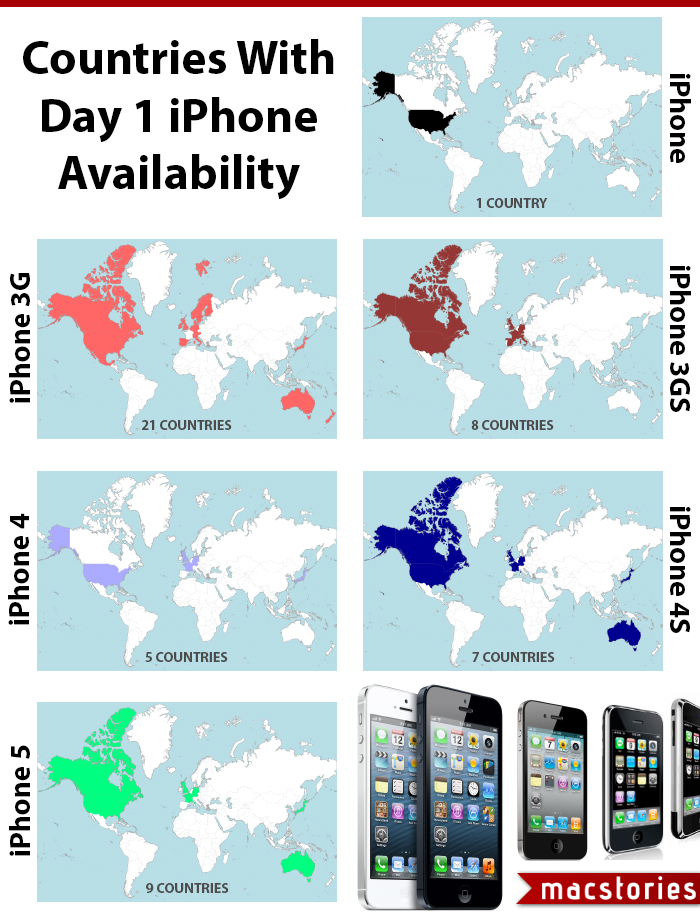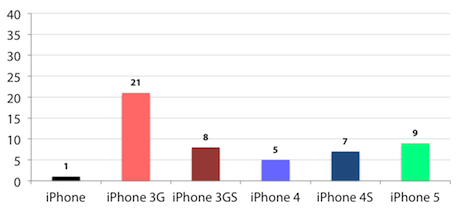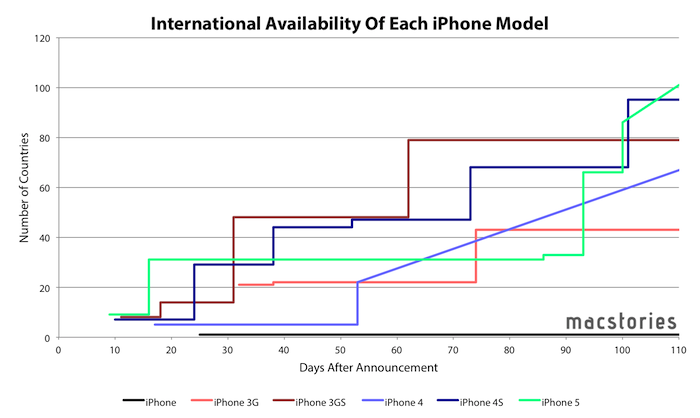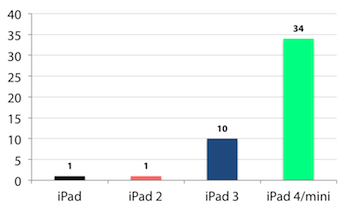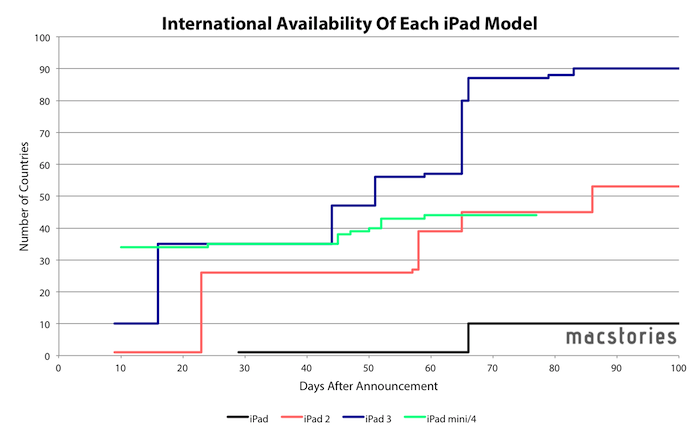Apple has on three seperate occasions announced that the iPhone 5 will have the fastest international rollout of any iPhone ever - at the announcement keynote, during the Q4 earnings call, and in their press release announcing opening weekend sales of the iPhone 5 in China. The claim was, no doubt, meant to impress investors, press and the general public, but I was curious as to how fast it really was compared to previous iPhone rollouts. So I decided to track down the launch schedules of all the iPhones to date and then again with the iPad. In the end I found a few trends, some oddities and that Apple’s claim was (mostly) true.
iPhone 5 will be available in more than 100 countries by the end of December, making it the fastest iPhone rollout ever.
Collating the data
My original goal was to track when every single country got each of the iPhone models, but it was simply impossible to track that much information down. I scaled back and decided to track down data for the first one hundred days of each iPhone and iPad - this proved much more attainable. My research started by looking back at Apple’s official press releases which often detail which countries are included in iPhone and iPad launch rollouts. However, Apple only does this for major “waves” of the international rollout, leaving massive holes in the timeline - to fill those in I fired up Google and tracked down news articles, blog posts and Wikipedia articles that detailed availability in other countries within the first 100 days. Thanks in particular to the following websites:
- Wikipedia (very helpful lists for some of the more recent devices)
- SeekingAlpha (for the excellent earnings call transcripts)
- MacRumors
- TUAW
- AllThingsD
- iMore
- 9to5 Mac
- AppleInsider
- Reuters
- WSJ
By and large I believe I have tracked down the accurate data for when the international rollouts occurred, but there are two exceptions in which I just couldn’t find enough data:
- iPhone 4: Despite searching like mad, I just couldn’t find enough data on the international rollout of this device. But I did discover in an Apple earnings call, made 133 days after the announcement that the device was available in 85 countries. With no idea when or which countries received the device, I resigned to just adding a diagonal line that gives a vague idea of the launch pattern.
- iPhone 5: Apple re-iterated in a press release in mid-December that it would hit over 100 countries by the end of December. Unfortunately I can’t track down which countries that includes - but given the PR was released so close to the end of December, I’m inclined to assume Apple would have met that goal. Consequently, you’ll see another diagonal line for the last bit of the iPhone 5 line.
The iPhone timeline goes to 110 days, mostly because there were a few data points (notably the iPhone 5) that were just beyond day 100 that I felt should be included. The iPad timeline goes to 100 days.
A note on interpreting the timeline
“Day 0” as shown on the graph is the day Apple held their keynote introducing the product, so you’ll see the lines start a number of days later. This seemed the fairest method to use, given some products arrived in more countries because they took much longer to launch (see the iPhone 3G as the clearest example).
iPhone
Initial Availability
Focusing first on inital device availability, the real oddity is that the iPhone 3G had the biggest international availability at 21 countries. But that big day one bang came at the cost of a greatly delayed launch - 32 days after it was announced. The subsequent year Apple drastically cut back the time to launch (11 days) and went with a smaller group of countries for the initial availability. Also of note is the iPhone 4’s initial launch which was also quite delayed at 17 days after the announcement and only had 5 launch countries. Jumping to the iPhone 5, its launch day saw the device arrive in nine countries (second to the 3G’s 21) only nine days after the announcement.
iPhone, iPhone 3G & iPhone 3GS
- The original iPhone was announced about six months prior to availability, so I took “day 0” as the day when Apple announced when the iPhone would ship.
- The iPhone 3G had two major waves in the first 110 days - the initial launch which covered the US, Canada, Australia, Japan and most of Western Europe and then the second wave 74 days after the announcement which saw more of Europe and a number of South American countries.
- The iPhone 3GS was able to nearly double the number of countries in the first 100 days compared to the 3G but it had a slower start. The initial launch was much more modest but it did have another wave of countries just a week later and then two more very large waves of over 30 countries after 34 days and after 62 days.
iPhone 4, iPhone 4S
- As noted above, I could not find reliable data for the iPhone 4’s international availability apart from the first two waves as Apple announced. Those two waves alone show a very slow ramp up - likely related to the new design (remember the various issues Apple had with that design from the white model to the glass and the antenna). The diagonal line simply connects the known data from the second wave to what Apple announced in an earnings call (that 133 days after the announcement it had launched in 85 countries).
- The iPhone 4S was much quicker than the 4, but it mostly lagged the ramp-up of the iPhone 3GS until day 101 when it added 27 countries to have a total of 95 countries - beating the 3GS’s 79 countries.
iPhone 5
- The iPhone 5 had its first two waves of availability really soon after the announcement, giving it a big ramp-up at the start with 31 countries having the device just 16 days after the announcement. But then it was quiet for a very long time, losing out to most of the other generations, until the very end when it saw a few large waves in rapid succession.
- Those last few waves saw the iPhone 5 go from being available in 31 countries to over 100 in under 30 days.
- There are two factors that I think contributed to the long pause on the international rollout of the iPhone 5 in that middle period.
- Apple was trying to ramp up supply to meet demand in those initial 31 countries (remember the delayed shipping times?).
- The iPad mini arrived about a month into the iPhone 5’s availability and that would have probably also strained Apple’s supply chain to its limits.
iPad
Initial Availability
Both the initial iPad and the iPad 2 were only available in the US on day one (although the iPad 2 arrived much quicker) and the 3rd generation iPad launched in 10 countries. But the real surprise is the iPad mini and 4th generation iPad which launched in an incredible 34 countries just 10 days after the announcement. That’s easily the biggest number of countries getting an iOS device on day one - solidly besting the old record of the iPhone 3G which was available in 21 countries (and that took 32 days to launch).
Other notes:
- The iPad 2, 3rd-gen iPad and iPad mini all seem to have a more graduated launch rollout compared to the recent iPhones - with more waves but with less countries being added at the same time (compare the smaller steps in this diagram to that of the iPhone).
- The iPad mini has been like the iPhone 5 in that it had a rapid initial rollout and then paused for a while (being overtaken by previous generation rollouts). It saw some small pre-Christmas waves going from 35 countries to 43 countries. My guess is that it’ll receive a big boost towards the end of the 100 days like the iPhone 5 and reach about 100 countries.
Final Comments
iPhone 5: Fastest Rollout Ever?
Well, yes and no. If you look at the iPhone rollout graph above, you’ll see that the lime green line is the highest for a short period at the start and then right at the end when it jumps up above the 4S. So it really depends what time frame you’re looking at: if it’s the first month or first 110 days, then yes, it’s true. But if you specify the time period to be the first 70 days then it’s actually the 3GS that had the fastest rollout with 79 countries whilst the iPhone 5 is in a measly 31 countries.
Expect device availability 9 or 10 days after the keynote
The last two iPhones and last 3 iPads all become available 9 or 10 days after Apple held its keynote - and all on a Friday. So if you know the keynote date, you can bet with reasonable confidence that the new device will go on sale on the following week’s Friday.
Download the Data File
If you want to get all the data I collated, I’ve decided to upload the Excel file which includes all my working out, charts and also includes which countries were included in each of the launch waves. You can download it here.



